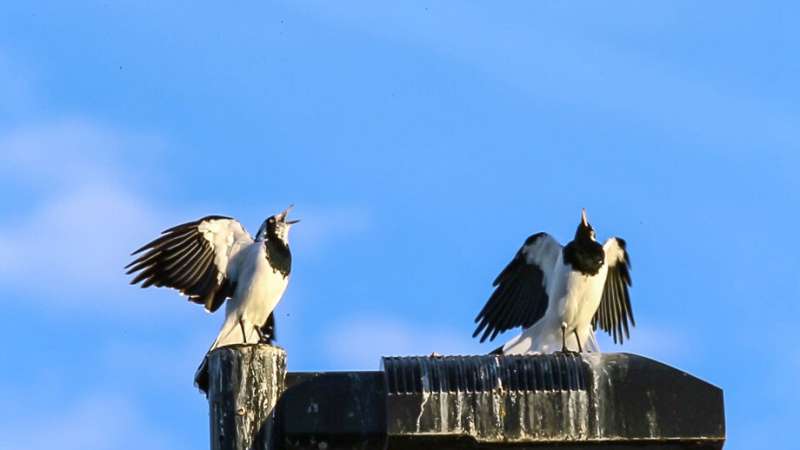Reality and illusion in magpie-lark song-and-dance duets

A new study shows Australian magpie-larks may use a ventriloquial illusion to make their vocal duets more threatening.
Co-author Professor Rob Magrath from The Australian University (ANU) said that during their duets, magpie-lark pairs coordinate loud calls and wing movements to use both audio and visual cues to communicate.
Animals use a large variety of signals to communicate, with some species calling, while others use bright colors, flashy dance moves or seductive perfumes.
"We found that the wing movement of magpie-larks helps to enhance duets by revealing where the sound is coming from," Professor Rob Magrath said.
Co-author Dr. Paweł Ręk from the Adam Mickiewicz University and Visiting Fellow at ANU added that both male and female magpie-larks regularly sing, but when they become a mated pair they coordinate their songs to perform a duet.
"These vocal duets are their main territorial signal, and even playback from speakers provokes a rapid response by neighbors," Dr. Ręk said.
An experienced pair of birds who have been together longer can perform their duets with incredible precision.
"These well-coordinated calls are more threatening to other birds than the shabby, less rehearsed calls from newer pairings," Professor Magrath said. "Vocal duets are also more effective if the callers are close together, as they are perceived as a threatening and united team."
But listeners can struggle to tell where the sound is coming from. This is where the wing-waving behavior comes in. The researchers used robotic magpie-lark models to perform wing movements, and loudspeakers to broadcast their songs.
"The exciting thing with the experiment was the ability to have the models and speakers in different places, allowing us to test how wing motion affected sound perception," Dr. Ręk said. "When the two speakers were placed apart, we found it created a less effective signal than if the speakers were together. However, with the speakers still apart but the robotic birds together, the wing movement created a stronger response by the listeners—as if the callers were actually close together."
For magpie-larks and humans alike, the researchers say our perception of the world is a mental construct, and not always a reflection of reality.
"For example, when you're watching TV, you see someone opening and closing their mouth, and you hear the sound of their voice from a nearby speaker. Your brain then constructs an illusion where the sound is coming from that person's mouth," Professor Magrath said. "We think that magpie-larks moving their wings up and down creates a similar illusion, and acts as a way of enhancing the duet.
"In the real world, background noise and echoes can make it difficult to tell where calls come from, so the wing-waving display helps confirm when birds are together."
This research was done in conjunction with the Adam Mickiewicz University, Poland. The study is published in Proceedings of the Royal Society B.
More information: Paweł Ręk et al, Reality and illusion: the assessment of angular separation of multi-modal signallers in a duetting bird, Proceedings of the Royal Society B: Biological Sciences (2022). DOI: 10.1098/rspb.2022.0680
Journal information: Proceedings of the Royal Society B
Provided by Australian National University





















